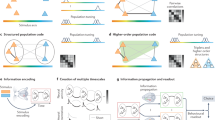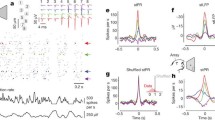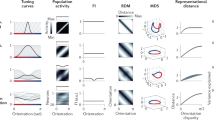Abstract
Physiological mechanisms of neuronal information processing have been shaped during evolution by a continual interplay between organisms and their sensory surroundings. Thus, when asking for the functional significance of such mechanisms, the natural conditions under which they operate must be considered. This has been done successfully in several studies that employ sensory stimulation under in vivo conditions. These studies address the question of how physiological mechanisms within neurons are properly adjusted to the characteristics of natural stimuli and to the demands imposed on the system being studied. Results from diverse animal models show how neurons exploit natural stimulus statistics efficiently by utilizing specific filtering capacities. Mechanisms that allow neurons to adapt to the currently relevant range from an often immense stimulus spectrum are outlined, and examples are provided that suggest that information transfer between neurons is shaped by the system-specific computational tasks in the behavioral context.
Similar content being viewed by others
References
Dodge F. A., Jr. and Rahamimoff R. (1967) Cooperative action of calcium ions in transmitter release at the neuromuscular junction. J. Physiol. 193, 419–432.
Fatt P. and Katz B. (1951) An analysis of the end-plate potential recorded with an intra-cellular electrode. J. Physiol. 115, 320–370.
Thaler C., Li W., and Brehm P. (2001) Calcium channel isoforms underlying synaptic transmission at embryonic Xenopus neuromuscular junctions. J. Neurosci. 21, 412–422.
Yau K. W. and Nakatani K. (1985) Light-induced reduction of cytoplasmic free calcium in retinal rod outer segment. Nature 313, 579–582.
Nakatani K. and Yau K. W. (1988) Calcium and light adaptation in retinal rods and cones. Nature 334, 69–71.
Matthews H. R. and Fain G. L. (2001) A light-dependent increase in free Ca2+ concentration in the salamander rod outer segment. J. Physiol. 532, 305–321.
Jentsch T. J. (2000) Neuronal KCNQ potassium channels: physiology and role in disease. Nat. Rev. Neurosci. 1, 21–30.
Sah P. (1996) Ca(2+)-activated K+ currents in neurones: types, physiological roles and modulation. Trends Neurosci. 19, 150–154.
Wu L. G., Westenbroek R. E., Borst J. G., Catterall W. A., and Sakmann B. (1999) Calcium channel types with distinct presynaptic localization couple differentially to transmitter release in single calyx-type synapses. J. Neurosci. 19, 726–736.
Turner R. W., Maler L., and Burrows M. (1999) Electroreception and electrocommunication. J. Exp. Biol. 202, 1167–1458.
Heiligenberg W. (1976) Electrolocation and jamming avoidance in the mormyrid fish Brienomyrus. J. Comp. Physiol. [A] 109, 357–372.
Westby G. W. M. (1974) Assessment of the signal value of certain discharge patterns in the electric fish, Gymnotus carapo, by means of playback. J. Comp. Physiol. [A] 92, 327–341.
Knudsen E. (1974) Behavioral thresholds to electric signals in high frequency electric fish. J. Comp. Physiol. [A] 91, 333–353.
Rose G. J. and Fortune E. S. (1996) New techniques for making whole-cell recordings from CNS neurons in vivo. Neurosci. Res. 26, 89–94.
Fortune E. S. and Rose G. J. (1997) Passive and active membrane properties contribute to the temporal filtering properties of midbrain neurons in vivo. J. Neurosci. 17, 3815–3825.
Haag J. and Borst A. (1996) Amplification of high-frequency synaptic inputs by active dendritic membrane processes. Nature 379, 639–641.
Hausen K. (1984) The lobula-complex of the fly: structure, function and significance in visual behaviour, in Photoreception and vision in invertebrates (Ali M. A., ed.), Plenum Press, New York, London, pp. 523–559.
Egelhaaf M. and Borst A. (1993) A look into the cockpit of the fly: visual orientation, algorithms, and identified neurons. J. Neurosci. 13, 4563–4574.
Egelhaaf M., Kern R., Krapp H. G., Kretzberg J., Kurtz R., and Warzecha A.-K. (2002) Neural encoding of behaviourally relevant visual-motion information in the fly. Trends Neurosci. 25, 96–102.
Hausen K. (1982) Motion sensitive interneurons in the optomotor system of the fly: II. The horizontal cells: receptive field organization and response characteristics. Biol. Cybern. 46, 67–79.
Hausen K. (1982) Motion sensitive interneurons in the optomotor system of the fly: I. The horizontal cells: structure and signals. Biol. Cybern. 45, 143–156.
Krapp H. G. and Hengstenberg R. (1996) Estimation of self-motion by optic flow processing in single visual interneurons. Nature 384, 463–466.
Egelhaaf M. (1985) On the neuronal basis of figure-ground discrimination by relative motion in the visual system of the fly: III. Possible input circuitries and behavioural significance of the FD-cells. Biol. Cybern. 52, 267–280.
Egelhaaf M. (1985) On the neuronal basis of figure-ground discrimination by relative motion in the visual system of the fly: II. Figure-detection cells, a new class of visual interneurons. Biol. Cybern. 52, 195–209.
Kimmerle B. and Egelhaaf M. (2000) Performance of fly visual interneurons during object fixation. J. Neurosci. 20, 6256–6266.
Haag J., Theunissen F., and Borst A. (1997) The intrinsic electrophysiological characteristics of fly lobula plate tangential cells: II. Active membrane properties. J. Comput. Neurosci. 4, 349–369.
Haag J. and Borst A. (1998) Active membrane properties and signal encoding in graded potential neurons. J. Neurosci. 18, 7972–7986.
Durr V., Kurtz R., and Egelhaaf M. (2001) Two classes of visual motion sensitive interneurons differ in direction and velocity dependency of in vivo calcium dynamics. J. Neurobiol. 46, 289–300.
Gauck V., Egelhaaf M., and Borst A. (1997) Synapse distribution on VCH, an inhibitory, motion-sensitive interneuron in the fly visual system. J. Comp. Neurol. 381, 489–499.
van Hateren J. H. (1997) Processing of natural time series of intensities by the visual system of the blowfly. Vision Res. 37, 3407–3416.
Weckstrom M. and Laughlin S. B. (1995) Visual ecology and voltage-gated ion channels in insect photoreceptors. Trends Neurosci. 18, 17–21.
Laughlin S. B. and Weckstrom M. (1993) Fast and slow photoreceptors—a comparative study of the functional diversity of coding and conductance in the Diptera. J. Comp. Physiol. [A] 172, 593–609.
Mendenhall B. and Murphey R. K. (1974) The morphology of cricket giant interneurons. J. Neurobiol. 5, 565–580.
Baba Y., Hirota K., Shimozawa T., and Yamaguchi T. (1995) Differing afferent connections of spiking and nonspiking wind-sensitive local interneurons in the terminal abdominal ganglion of the cricket Gryllus bimaculatus. J. Comp. Physiol. [A] 176, 17–30.
Jacobs G. A. and Miller J. P. (1985) Functional properties of individual neuronal branches isolated in situ by laser photoinactivation. Science 228, 344–346.
Jacobs G. A., Miller J. P., and Murphey R. K. (1986) Integrative mechanisms controlling directional sensitivity of an identified sensory interneuron. J. Neurosci. 6, 2298–2311.
Ogawa H., Baba Y., and Oka K. (1996) Dendritic Ca2+ response in cercal sensory interneurons of the cricket Gryllus bimaculatus. Neurosci. Lett. 219, 21–24.
Ogawa H., Baba Y., and Oka K. (1999) Dendritic Ca2+ transient increase evoked by wind stimulus in the cricket giant interneuron. Neurosci. Lett. 275, 61–64.
Ogawa H., Baba Y., and Oka K. (2000) Spike-dependent calcium influx in dendrites of the cricket giant interneuron. J. Neurobiol. 44, 45–56.
Ogawa H., Baba Y., and Oka K. (2001) Dendritic calcium accumulation regulates wind sensitivity via short-term depression at cercal sensory-to-giant interneuron synapses in the cricket. J. Neurobiol. 46, 301–313.
Howard J., Blakeslee B., and Laughlin S. B. (1987) The intracellular pupil mechanism and photoreceptor signal: noise ratios in the fly Lucilia cuprina. Proc. R. Soc. Lond B Biol. Sci. 231, 415–435.
Laughlin S. B., Howard J., and Blakeslee B. (1987) Synaptic limitations to contrast coding in the retina of the blowfly Calliphora. Proc. R. Soc. Lond B Biol. Sci. 231, 437–467.
Laughlin S. B. (1981) A simple coding procedure enhances a neuron’s information capacity. Z. Naturforsch. 36c, 910–912.
French A. S., Korenberg M. J., Jarvilehto M., Kouvalainen E., Juusola M., and Weckstrom M. (1993) The dynamic nonlinear behavior of fly photoreceptors evoked by a wide range of light intensities. Biophys. J. 65, 832–839.
Juusola M. and Weckstrom M. (1993) Band-pass filtering by voltage-dependent membrane in an insect photoreceptor. Neurosci. Lett. 154, 84–88.
Juusola M., Kouvalainen E., Jarvilehto M., and Weckstrom M. (1994) Contrast gain, signal-to-noise ratio, and linearity in light-adapted blowfly photoreceptors. J. Gen. Physiol. 104, 593–621.
Juusola M. and Hardie R. C. (2001) Light adaptation in Drosophila photoreceptors: I. Response dynamics and signaling efficiency at 25 degrees C. J. Gen. Physiol. 117, 3–25.
Juusola M. and Hardie R. C. (2001) Light adaptation in Drosophila photoreceptors: II. Rising temperature increases the bandwidth of reliable signaling. J. Gen. Physiol. 117, 27–42.
Weckstrom M., Hardie R. C., and Laughlin S. B. (1991) Voltage-activated potassium channels in blowfly photoreceptors and their role in light adaptation. J. Physiol. 440, 635–657.
Sobel E. C. and Tank D. W. (1994) In vivo Ca2+ dynamics in a cricket auditory neuron: an example of chemical computation. Science 263, 823–825.
Maddess T. and Laughlin S. B. (1985) Adaptation of the motion-sensitive neuron H1 is generated locally and governed by contrast frequency. Proc. R. Soc. Lond B Biol. Sci. 228, 251–275.
Jian S. and Horridge G. A. (1991) The H1 neuron measures change in velocity irrespective of contrast frequency, mean velocity or velocity modulation frequency. Philos. Trans. R. Soc. Lond B Biol. Sci. 331, 205–211.
Fairhall A. L., Lewen G. D., Bialek W., and de Ruyter van Steveninck R. R. (2001) Efficiency and ambiguity in an adaptive neural code. Nature 412, 787–792.
Harris R. A., O’Carroll D. C., and Laughlin S. B. (2000) Contrast gain reduction in fly motion adaptation. Neuron 28, 595–606.
Kurtz R., Durr V., and Egelhaaf M. (2000) Dendritic calcium accumulation associated with direction-selective adaptation in visual motion-sensitive neurons in vivo. J. Neurophysiol. 84, 1914–1923.
Harris R. A., O’Carroll D. C., and Laughlin S. B. (1999) Adaptation and the temporal delay filter of fly motion detectors. Vision Res. 39, 2603–2613.
Clifford C. W. and Langley K. (1996) A model of temporal adaptation in fly motion vision. Vision Res. 36, 2595–2608.
de Ruyter van Steveninck R. R., Zaagman W. H., and Mastebroeck H.A.K. (1986) Adaptation of transient responses of a movement-sensitive neuron in the visual system of the blowfly Calliophora erythrocephala. Biol. Cybern. 54, 223–236.
Durr V. and Egelhaaf M. (1999) In vivo calcium accumulation in presynaptic and postsynaptic dendrites of visual interneurons. J. Neurophysiol. 82, 3327–3338.
Borst A. and Egelhaaf M. (1992) In vivo imaging of calcium accumulation in fly interneurons as elicited by visual motion stimulation. Proc. Natl. Acad. Sci. USA 89, 4139–4143.
Brenner N., Bialek W., and de Ruyter van Steveninck R. R. (2000) Adaptive rescaling maximizes information transmission. Neuron 26, 695–702.
Fortune E. S. and Rose G. J. (2000) Short-term synaptic plasticity contributes to the temporal filtering of electrosensory information. J. Neurosci. 20, 7122–7130.
Fortune E. S. and Rose G. J. (2001) Short-term synaptic plasticity as a temporal filter. Trends Neurosci. 24, 381–385.
Juusola M., Uusitalo R. O., and Weckstrom M. (1995) Transfer of graded potentials at the photoreceptor-interneuron synapse. J. Gen. Physiol. 105, 117–148.
Juusola M., French A. S., Uusitalo R. O., and Weckstrom M. (1996) Information processing by graded-potential transmission through tonically active synapses. Trends Neurosci. 19, 292–297.
von Gersdorff H. (2001) Synaptic ribbons: versatile signal transducers. Neuron 29, 7–10.
Morgans C. W. (2000) Neurotransmitter release at ribbon synapses in the retina. Immunol. Cell Biol. 78, 442–446.
Attwell D., Borges S., Wu S. M., and Wilson M. (1987) Signal clipping by the rod output synapse. Nature 328, 522–524.
Kurtz R., Warzecha A. K., and Egelhaaf M. (2001) Transfer of visual motion information via graded synapses operates linearly in the natural activity range. J. Neurosci. 21, 6957–6966.
Hengstenberg R. (1982) Common visual response properties of giant vertical cells in the lobula plate of the blowfly Calliphora. J. Comp. Physiol. [A] 149, 179–193.
Hengstenberg R., Hausen K., and Hengstenberg B. (1982) The number and structure of giant vertical cells (VS) in the lobula plate of the blowfly Calliphora erythrocephala. J. Comp. Physiol. [A] 149, 163–177.
Krapp H. G., Hengstenberg B., and Hengstenberg R. (1998) Dendritic structure and receptive-field organization of optic flow processing interneurons in the fly. J. Neurophysiol. 79, 1902–1917.
Warzecha A. K., Kurtz R., and Egelhaaf M. (2003) Synaptic transfer of dynamical motion information between identified neurons in the visual system of the blowfly, Neurosci. (in press).
Warzecha A. K., Kretzberg J., and Egelhaaf M. (1998) Temporal precision of the encoding of motion information by visual interneurons. Curr. Biol. 8, 359–368.
Hausen K. and Egelhaaf M. (1989) Neural mechanisms of visual course control in insects, in Facets of Vision (Stavenga D. G. and Hardie R. C., eds.), Springer, Berlin, Heidelberg, pp. 391–424.
Augustine G. J. (2001) How does calcium triggner neurotransmitter release? Curr. Opin. Neurobiol. 11, 320–326.
Bollmann J. H., Sakmann B., and Borst J. G. (2000) Calcium sensitivity of glutamate release in a calyx-type terminal. Science 289, 953–957.
Heidelberger R., Heinemann C., Neher E., and Matthews G. (1994) Calcium dependence of the rate of exocytosis in a synaptic terminal. Nature 371, 513–515.
Qian J. and Noebels J. L. (2001) Presynaptic Ca2+ channels and neurotransmitter release at the terminal of a mouse cortical neuron. J. Neurosci. 21, 3721–3728.
Schneggenburger R. and Neher E. (2000) Intracellular calcium dependence of transmitter release rates at a fast central synapse. Nature 406, 889–893.
Smith S. J., Augustine G. J., and Charlton M. P. (1985) Transmission at voltage-clamped giant synapse of the squid: evidence for cooperativity of presynaptic calcium action. Proc. Natl. Acad. Sci. USA 82, 622–625.
Wu L. G. and Saggau P. (1994) Presynaptic calcium is increased during normal synaptic transmission and paired-pulse facilitation, but not in long-term potentiation in area CA1 of hippocampus. J. Neurosci. 14, 645–654.
Ivanov A. I. and Calabrese R. L. (2000) Intracellular Ca2+ dynamics during spontaneous and evoked activity of leech heart interneurons: low-threshold Ca currents and graded synaptic transmission. J. Neurosci. 20, 4930–4943.
Haag J. and Borst A. (2000) Spatial distribution and characteristics of voltage-gated calcium signals within visual interneurons. J. Neurophysiol. 83, 1039–1051.
Witkovsky P., Schmitz Y., Akopian A., Krizaj D., and Tranchina D. (1997) Gain of rod to horizontal cell synaptic transfer: relation to glutamate release and a dihydropyridine-sensitive calcium current. J. Neurosci. 17, 7297–7306.
Gleason E., Borges S., and Wilson M. (1994) Control of transmitter release from retinal amacrine cells by Ca2+ influx and efflux. Neuron 13, 1109–1117.
Beutner D., Voets T., Neher E., and Moser T. (2001) Calcium dependence of exocytosis and endocytosis at the cochlear inner hair cell afferent synapse. Neuron 29, 681–690.
von Gersdorff H. (2001) Synaptic ribbons: versatile signal transducers. Neuron 29, 7–10.
Stewart B. A., Mohtashami M., Trimble W. S., and Boulianne G. L. (2000) SNARE proteins contribute to calcium cooperativity of synaptic transmission. Proc. Natl. Acad. Sci. USA 97, 13,955–13,960.
Brandstatter J. H., Wassle H., Betz H., and Morgans C. W. (1996) The plasma membrane protein SNAP-25, but not syntaxin, is present at photoreceptor and bipolar cell synapses in the rat retina. Eur. J. Neurosci. 8, 823–828.
Morgans C. W., Gaughwin P., and Maleszka R. (2001) Expression of the alpha1F calcium channel subunit by photoreceptors in the rat retina. Mol. Vis. 7, 202–209.
Passaglia C., Dodge F., Herzog E., Jackson S., and Barlow R. (1997) Deciphering a neural code for vision. Proc. Natl. Acad. Sci. USA 94, 12,649–12,654.
Ilg U. J. and Thier P. (1996) Inability of rhesus monkey area V1 to discriminate between self-induced and externally induced retinal image slip. Eur. J. Neurosci. 8, 1156–1166.
Kern R., Lutterklas M., and Egelhaaf M. (2000) Neuronal representation of optic flow experienced by unilaterally blinded flies on their mean walking trajectories. J. Comp. Physiol. [A] 186, 467–479.
Kern R., Lutterklas M., Petereit C., Lindemann J. P., and Egelhaaf M. (2001) Neuronal processing of behaviourally generated optic flow: experiments and model simulations. Network: Comput. Neural Syst. 12, 351–369.
Kern R., Petereit C., and Egelhaaf M. (2001) Neural processing of naturalistic optic flow. J. Neurosci. 21, RC139.
Kimmerle B. and Egelhaaf M. (2000) Detection of object motion by a fly neuron during simulated flight. J. Comp. Physiol. [A] 186, 21–31.
Hateren J. H. and Schilstra C. (1999) Blowfly flight and optic flow. II. Head movements during flight. J. Exp. Biol. 202 (Pt 11), 1491–1500.
Schilstra C. and van Hateren J. H. (1998) Using miniature sensor coils for simultaneous measurement of orientation and position of small, fast-moving animals. J. Neurosci. Methods 83, 125–131.
Schilstra C. and van Hateren J. H. (1998) Stabilizing gaze in flying blowflies. Nature 395, 654.
Schilstra C. and Hateren J. H. (1999) Blowfly flight and optic flow. I. Thorax kinematics and flight dynamics. J. Exp. Biol. 202 (Pt 11), 1481–1490.
Lindemann J. P., Kern R., Michaelis C., Meyer P., van Hateren J. H., and Egelhaaf M. (2003). FliMax, a novel stimulus device for panaromic and highspeed presentation of behaviorally generated optic flow. Vis. Res. 43, 779–791.
O’Keefe J. (1976) Place units in the hippocampus of the freely moving rat. Exp. Neurol. 51, 78–109.
Helmchen F., Fee M. S., Tank D. W., and Denk W. (2001) A miniature head-mounted two-photon microscope. high-resolution brain imaging in freely moving animals. Neuron 31, 903–912.
Author information
Authors and Affiliations
Corresponding author
Rights and permissions
About this article
Cite this article
Kurtz, R., Egelhaaf, M. Natural patterns of neural activity. Mol Neurobiol 27, 13–31 (2003). https://doi.org/10.1385/MN:27:1:13
Issue Date:
DOI: https://doi.org/10.1385/MN:27:1:13




